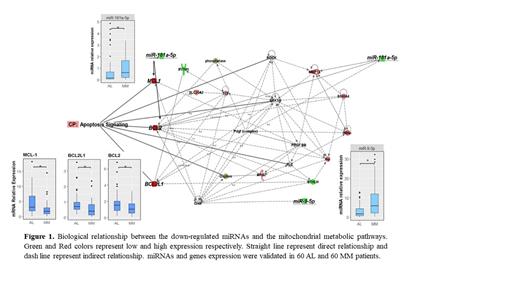Abstract
Background: Systemic light chain (AL) amyloidosis is a clonal plasma cell disorder characterized by deposition of misfolded immunoglobulin light chain products in vital organs, causing their dysfunction. All therapies used to treat AL patients are adapted from multiple myeloma (MM) and customized to the typically frail AL population. Hence, it is important to identify novel therapeutic targets for these patients. MicroRNAs (miRNAs) are short, non-coding RNAs that regulate gene expression and have a role in cancer development and progression. MiRNAs can be purified from serum, plasma and bone marrow (BM) and may be used as biomarkers to distinguish between patients and healthy individuals. Moreover, miRNA-mRNA interactions may determine the molecular mechanism involved in AL pathogenesis and may suggest novel therapeutic approaches. To date, knowledge about circulating or BM miRNAs involved in AL amyloidosis is lacking.
Aims: To decipher specific miRNA expression profiles in AL amyloidosis compared to MM patients and healthy controls (HC) and to examine how miRNAs are involved in AL pathogenesis.
Methods: miRNA expression profile was determined using the nCounter assay (NanoString technologies). RNA-Seq data was downloaded from GEO database (GSE175384), and was used to detect potential miRNA-mRNA targets, and enriched biological pathways by the bioinformatics tool Ingunity Pathway Analysis (IPA). MiRNA and gene expression profiles were validated by qRT-PCR in 60 AL, 60 MM and 10 HC samples. The effect of aberrantly expressed miRNAs on potential molecular targets was analyzed in ALMC1 cells by transfecting the cells with miRNA mimic, following qRT-PCR, Western blot analysis and Annexin-PI staining.
Results: BM and plasma miRNAs were differentially expressed in AL amyloidosis compared to MM or HC. MiRs-9a-5p, 181a-5p, 199a-3p, 130a-3p, 145-5p and 301a-3p were differentially expressed between AL and MM samples and may be used as biomarkers for distinguish AL amyloidosis from MM. Moreover, we found that the differentially expressed miRNAs and mRNA in AL patients regulates key signaling pathways related to cell cycle and anti-apoptosis mechanisms including cytokine signaling, oxidative phosphorylation (OXPHOS), NFkB signaling, activation of MAPK and PI3K/AKT pathways, which are all linked to cancer cell growth, proliferation and therapeutic resistance, and therefore may be used as a therapeutic targets. Specifically, our analysis showed that genes related to mitochondrial activity were upregulated in AL patients (Figure 1), particularly the anti-apoptotic BCL2 family genes (BCL2, MCL1, and BCL2L1). MCL1 and BCL2L1 are predicted targets of miR-181a-5p that was downregulated in BM and plasma samples of AL patients compared to MM patients, indicating a possible interaction between these molecules. MiR-9-5p, which was also found to be downregulated in AL BM and plasma samples compared to MM patients, is predicted to have an indirect effect on the BCL2 family members through CREB molecule (Figure 1).
The biological significance of miR-9-5p and miR-181a-5p was evaluated, by transfecting ALMC1 cell line with miRNA mimics. Overexpression of these miRNAs led to downregulation of the BCL2 family anti-apoptotic genes and induced apoptosis by Annexin V staining. These findings might explain the biological mechanism by which AL patients respond to the BCL2 inhibitor, venetoclax, as recently reported (Sidiqi et al, BCJ, 2020).
Conclusions: We provide insight into the molecular mechanisms mediated by miRNAs and the aberrant expression of oncogenic/tumor suppressor genes. The differential expression of miRNAs in AL amyloidosis may be used to understand disease pathogenesis and predict risk of progression to AL amyloidosis among patients with known plasma cell disorders. Additionally, signaling pathways involved in AL amyloidosis, mediated by miRNAs, may assist in tailoring more specific treatments.
Dispenzieri: Oncopeptides: Consultancy; Sorrento Therapeutics: Consultancy; Pfizer: Research Funding; Alnylam: Research Funding; Takeda: Research Funding; Janssen: Consultancy, Research Funding.


This feature is available to Subscribers Only
Sign In or Create an Account Close Modal